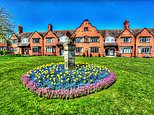
Landing a job at Port Sunlight’s soap factory must have been a big deal.
Industrialist William Lever began building a garden village for the workers of his factory in the Wirral in 1888 — and it remains a delight. I explore on a day when the leafy streets are deserted; the architecture, solid and skilfully constructed, doesn’t easily reveal what year I’ve stepped into.
Imagine a mix of Elizabethan, Edwardian, Jacobean, even Dutch architecture, with a hint of Belle Époque and a feel of Arts and Crafts. I spot dormer, mullioned and even oriel windows, twisted chimney stacks, Doric columns and at least one turret.
Delightful: Tina Ediss visits Port Sunlight, which was founded by industrialist William Lever in 1888 to house workers of his soap factory (pictured)
No facade is ordinary when it could be ornate; nothing’s functional when it could be fancy. Only the finest materials were used, costs Lever never recouped in rent.
Born in Bolton in 1851, William Lever was the son of a grocer. Troubled by the squalor of inner-city slums, he believed good housing created a happy, healthy and loyal workforce.
The project was a coming together of Lever’s passion for business, architecture and social reform. Using the best architects, he planned a village of 900 houses set out on wide streets and boulevards, with the nearby factory neatly concealed.
I pick up the story in the Port Sunlight Museum. It starts with a film which sets the scene of happy employees enjoying the benefits of working for Lever Bros.
He’d thought of everything. The village included churches, schools, a cottage hospital, theatre, gym, heated outdoor swimming pool, tennis courts, allotments, open spaces and its own train station. Clubs and societies were also organised and pensions provided.
I set off on a walking tour. There’s a familiarity about it, perhaps because scenes from BBC’s Peaky Blinders were filmed here.
Sunlit uplands: Tina explores some of the cottages built for the factory workers (pictured)
There were two types of cottages; the three-bedroom kitchen cottage and the bigger four-bedroom parlour cottage. Each street had a mixture of both; the houses were built in blocks, each designed by a different architect.
I find it hard to stop myself peering in through the windows. Luckily, one cottage, 22 King George’s Drive, is open to the public and looks as it did when first built in 1913. A table sits in front of the range in the parlour with rag-rugs on the floor.
In the scullery, Sunlight soap products stand next to the washboard by the sink. Upstairs, the bedrooms are simply furnished and a generous size. Every house had a garden, a bathroom, and hot and cold running water — unheard of in those days.
Tina’s final stop was the Lady Lever Art Gallery, which contains Lever’s vast collection of paintings, sculptures, furniture and pottery
TRAVEL FACTS
Port Sunlight Experience (portsunlight village.com / 0151 644 4800) includes Museum, Worker’s Cottage and Soap Works. Adults £8, conc £7, child £5.50. Closed Mon/Tues. Guided walking tours; adults £7; conc £6, child £4. Lady Lever Art Gallery free. B&B doubles at Mere Brook House, Thornton Hough (merebrookhouse.co.uk, 07713 189949 ) from £109.
The village bowling green is neat and still in use. Nearby is the Soap Works. Once a school, it’s now a hands-on experience, with lessons in the science of soap.
The village was completed in 1914, just as war broke out and I pause at an impressive memorial dedicated to Lever employees lost in both World Wars.
From the memorial, my walk takes me through the rose gardens and past the site of the bandstand that once provided the villagers with entertainment.
My final stop is the Lady Lever Art Gallery, built in honour of Lever’s wife, Elizabeth, who died in 1913. It opened in 1922 and bursts its neoclassical seams with Lever’s vast collection of paintings, sculptures, furniture and pottery.
The village remained home to employees until the 1980s, when the houses started being sold. Two-thirds are now privately owned; the rest are cared for by the Port Sunlight Village Trust.
Port Sunlight is now a conservation area, so it’s kept tidy. I drive away thinking that living here must still be a very big deal.
Source link
CHECK OUT: Top Travel Destinations
READ MORE: Travel News



